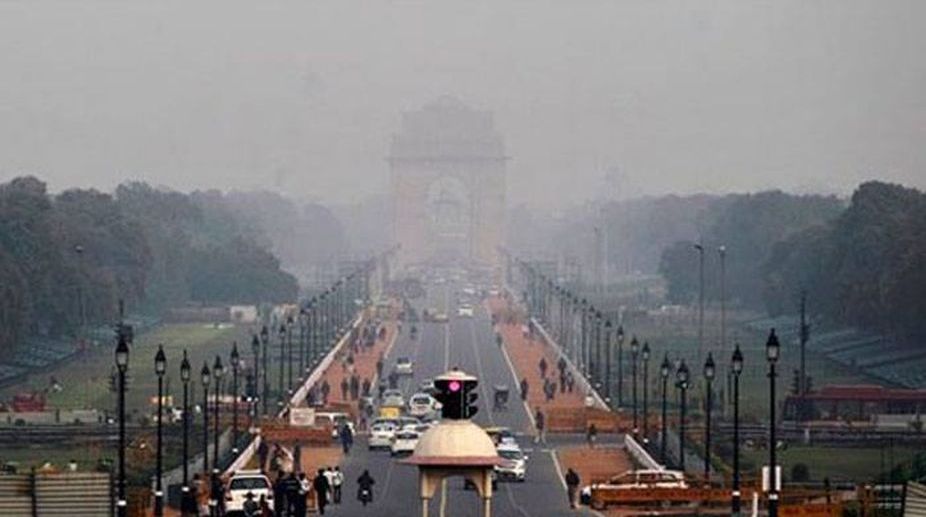GRAP Stage-2 revoked as Delhi’s air quality shows improvement
The forecast by IMD/ IITM also indicate the average AQI of Delhi to stay in 'Moderate/Poor' category with light rain/ drizzle expected in the coming days.

(Photo: Facebook)
Air quality in the National Capital Region on Thursday showed no improvement as the Air Quality Index (AQI) deteriorated a “little” and remained in the “very poor” category even as the National Green Tribunal (NGT) deferred its decision on ban on construction activities and the Delhi government’s plea for exemptions on the odd-even traffic scheme to Friday.
On Thursday, the Central Pollution Control Board (CPCB), recorded the AQI of Delhi-NCR at 362 at 6 p.m. as compared to 353 on Wednesday.
Weather monitoring stations of the CPCB at DTU and Anand Vihar stations found air quality in those areas in the “severe” bracket while other 17 stations in Delhi showed air quality in “very poor” category.
Advertisement
AQI in neighbouring Noida and Gurugram was found “severe” on Thursday.
The major pollutant PM2.5 or particles with diameter less than 2.5 micro meter, recorded 362 units putting it in “very poor” category while PM10 concentration was found at 281 units – considered as “poor”.
While the Supreme Court-monitored Environment Pollution Control Authority (EPCA) lifted ban on entry of trucks and on construction activities in Delhi, the ban on construction activities was to remain in force as the NGT did not pass any order in this regard on Thursday.
System of Air Quality and Weather Forecasting And Research (SAFAR), weather forecasting body under Ministry of Earth Science, has predicted levels of PM2.5 and PM10 in Delhi to remain in “very poor” and “poor” categories, respectively, on Friday.
EPCA member and Centre for Science and Environment (CSE) researcher Usman Nasim told IANS the pollution levels in the region may go up in coming days due to climatic conditions.
“Pollution may increase in next few days due to withdrawal of north-west winds. As wind speed goes down, pollution levels to go up. As per SAFAR, AQI will remain in very poor quality,” Nasim said.
He said the major contributing factor would be local vehicular emission now and increase in moisture would aggravate it.
He said stubble burning in states of Punjab, Haryana had almost came to an end.
Nasim warned that certain actions from EPCA may come again, in case AQI enters the severe category.
Mahesh Palwat, Director of Skymet, a private weather forecast agency, said air quality may show little improvement in the afternoon but it will remain in very poor category, mostly during morning and night hours.
“At present, it is snowing in Himachal Pradesh and Jammu & Kashmir. As its effect, winds from north-west and north will start and air pollution will decrease in Delhi from November 20. The wind speed will be around 20kmph,” Palawat told IANS.
EPCA had imposed restrictions under the “severe-plus” or “emergency” category of the Graded Response Action Plan (GRAP) on November 7, after a thick yellow blanket of smog covered Delhi due to the cumulative effect of stubble burning in neighbouring states and meteorological reasons.
Under the “severe-plus” category, according to rules, truck movement in Delhi was stopped, construction work was banned, odd-even scheme for vehicles was imposed and schools were shut.
The very-poor GRAP comes in force when PM2.5 levels are between 121-250 units or PM10 levels are between 351-430 units. Under very-poor, diesel generator sets are also banned and the motor parking fee is enhanced by three-four times to discourage private cars on roads.
On Thursday, the EPCA lifted the restrictions following improvement in the air quality.
As NGT deferred its decision on the odd-even scheme to Friday, construction activities would remain suspended till its further directions.
“As far as construction is concerned, it will not be allowed since the NGT ban is there,” Nasim said.
According to the report, titled ‘India State-level Disease Burden’ and released by Vice President M. Venkaiah Naidu recently, indoor air pollution also caused six per cent of the disease burden last year.
“The contribution of air pollution to disease burden remained high in India between 1990 and 2016, with levels of exposure among the highest in the world,” it said.
Advertisement